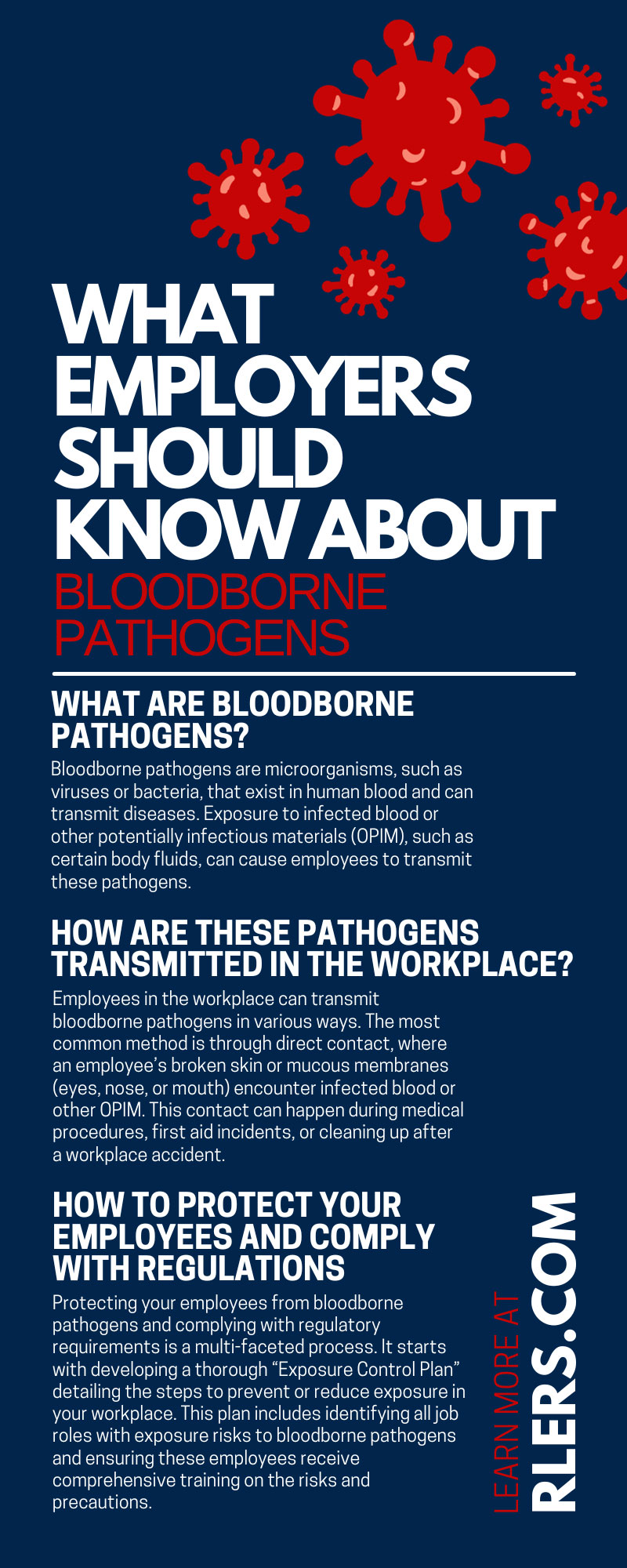
Being aware of the potential risks associated with your workplace is essential as an employer. Bloodborne pathogens are one of the most important topics when it comes to health and safety. Businesses must take serious precautions to protect their employees.
You’ll learn what these pathogens are, how people transmit them in the workplace, how to protect your employees, and more valuable information you don’t want to miss in this guide on what employers should know about bloodborne pathogens. Following a suitable protocol around these pathogens will ensure optimal compliance with industry regulations while protecting staff members from potential contamination.
What Are Bloodborne Pathogens?
Bloodborne pathogens are microorganisms, such as viruses or bacteria, that exist in human blood and can transmit diseases. Exposure to infected blood or other potentially infectious materials (OPIM), such as certain body fluids, can cause employees to transmit these pathogens.
Employers must be aware of bloodborne pathogens because any job function that involves handling or likely contact with blood or OPIM can potentially expose employees to these health risks. Understanding what these pathogens are and how they spread creates a safer, healthier work environment. Furthermore, Occupational Safety and Health Administration (OSHA) regulations require employers to protect workers from these health hazards.
Common Types of Bloodborne Pathogens
Understanding the common types of bloodborne pathogens that can pose risks in the workplace will help you protect your employees. Here are some of the most prevalent:
- Human Immunodeficiency Virus (HIV): This virus compromises the body’s immune system, making it harder for it to fight off diseases and infections.
- Hepatitis B (HBV): HBV is a virus that attacks the liver and can cause both acute and chronic disease. It’s a major global health risk and potentially life-threatening.
- Hepatitis C (HCV): Like HBV, HCV is primarily a bloodborne virus affecting the liver.
- Human T-lymphotropic virus (HTLV): This type of virus is rare and can cause a variety of health problems, including a type of cancer called adult T-cell leukemia/lymphoma (ATL).
- West Nile Virus: Although primarily transmitted by mosquitoes, organ transplantation and blood transfusion can cause this virus to spread.
- Zika Virus: Like the West Nile Virus, a mosquito bite is the most common transmission method but a blood transfusion can also cause the virus to spread.
Knowing these common types of bloodborne pathogens is a stepping stone to understanding the potential risks and implementing the necessary precautions in your workplace.
How Are These Pathogens Transmitted in the Workplace?
Employees in the workplace can transmit bloodborne pathogens in various ways. The most common method is through direct contact, where an employee’s broken skin or mucous membranes (eyes, nose, or mouth) encounter infected blood or other OPIM. This contact can happen during medical procedures, first aid incidents, or cleaning up after a workplace accident.
Additionally, employees can accidentally spread these pathogens through needle sticks or cuts from other sharp objects contaminated with an infected person’s blood or OPIM. Industries such as healthcare, cleaning services, tattoo parlors, and any profession involving blood draws or injections are particularly susceptible to transmission via this route.
As previously mentioned, mosquito bites commonly transmit bloodborne pathogens like the Zika and West Nile viruses in areas where these insects carry the viruses. While contracting either of these viruses is less common, it’s still a potential risk, especially for workers in construction, landscaping, or wildlife management.
How To Protect Your Employees and Comply With Regulations
Protecting your employees from bloodborne pathogens and complying with regulatory requirements is a multi-faceted process. It starts with developing a thorough “Exposure Control Plan” detailing the steps to prevent or reduce exposure in your workplace. This plan includes identifying all job roles with exposure risks to bloodborne pathogens and ensuring these employees receive comprehensive training on the risks and precautions.
Employers should enforce the use of Personal Protective Equipment (PPE) like gloves, face shields, gowns, and masks. Regularly replace and dispose of these items correctly to maintain their effectiveness. Consider engineering controls that isolate or remove the bloodborne pathogens hazard from the workplace, such as self-sheathing needles or safer medical devices.
Create and enforce a sharps disposal policy for jobs with a risk of sharp injuries. Provide puncture-resistant, leak-proof, and clearly labeled containers for disposing of sharps. Promoting a culture of hand hygiene is equally important. Encourage employees to wash their hands immediately after removing their PPE and contacting blood or other potentially infectious materials.
Regularly review and update your control measures and procedures to ensure they’re consistent with current health and safety guidelines. Remember, compliance with OSHA’s Bloodborne Pathogens Standard isn’t just about avoiding fines; it’s about the health and safety of your employees. So, make sure you’re doing everything you can to protect them.
What To Do When There Is an Exposure Incident
Swift and appropriate action is essential to safeguard the health of the affected employee in the event of an exposure incident. First, ensure immediate and thorough washing of the exposed area with soap and running water. You may need biohazard cleaning services to ensure you properly clean the area and remove the pathogens. Flush your eyes or mouth with water or saline solution for several minutes if the exposure involves these mucous membranes.
Next, as an employer, you must ensure you properly report the incident. You must complete an Exposure Incident Report outlining the event’s details, such as the circumstances under which the exposure occurred, the route of exposure, and any relevant information about the source individual, if known.
Refer the exposed employee for immediate medical evaluation and follow-up. This evaluation can include an assessment of reported illnesses, a blood test to check for potential infection, and the provision of preventative treatment, if appropriate.
Lastly, ensure that counseling is readily available for the affected employee, providing relevant information on the potential risks involved and an overview of the laws and regulations concerning the confidentiality of the patient in these events.
Following these steps promptly can help mitigate health risks, ensure appropriate care for the affected employee, and maintain compliance with health and safety regulations.
Understanding what employers should know about bloodborne pathogens is vital to ensuring workplace safety. Your key responsibility as an employer is to maintain a secure environment for your employees. We hope this guide has provided beneficial information to safeguard your team against these health risks. Maintaining regular communication about health and safety, coupled with continuous training, will go a long way in fostering a safe and healthy workplace.


